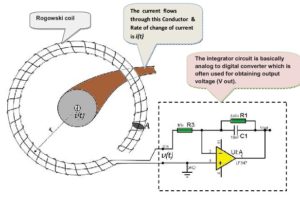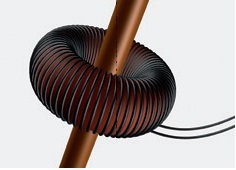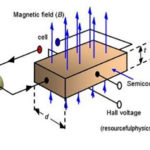Part 1 of this FAQ discussed the issue of current measurement and four transducers that can measure current. The first two — shunt resistors and Hall-effect devices — can be used for AC or DC currents. We will now look at two other transducers — the Rogowski coil and the current transformer—which can be used only for AC but are nevertheless in widespread use.
Q: What is a Rogowski coil?
A: Named after the German physicist Walter Rogowski, the Rogowski Coil is an electrical device used for measuring alternating current (AC) including high-speed transients, pulsed currents, and or line-power sinusoidal currents. It uses a helical coil of wire, and the lead from one end returns through the center of the coil to the other end; thus, both terminals are at the same end of the coil. Next, the assembly is wrapped around the straight conductor whose current is to be measured, without need for a metal (iron) core, Figure 1.

The voltage induced in the coil is proportional to the rate of change of current in the straight conductor, so the output of the Rogowski coil is usually connected to an analog integrator circuit to provide an output signal that is proportional to the current, or the integration function is implemented by a A/D converter and software.
Q: What are the major features of the Rogowski coil?
A: The coil has some interesting features:
- It is best suited to high-current levels, on the order of tens of amps and higher;
- It is coreless, so it can’t saturate;
- It can measure current from about 1 Hz to tens of kHz due to its low inductance;
- It is isolated from the current-carrying wire being sensed;
- Because it is an “open” magnetic circuit, it is susceptible to external magnetic fields unless it is shielded;
- It is low-cost;
- It requires an integrator to provide a meaningful output.
Q: What about using a basic transformer?
A: The classic transformer is often used as a current-measuring transducer, and it is quite effective in the right applications. In practice, it is built as a toroidal configuration, with the wire to be sensed passing through the center of the transformer core and windings, Figure 2.

The performance of the current-sense transformer is also determined by the specific magnetic material used for the core. Depending on the material, the design can tolerate a wider amount of DC component on the AC current; this DC component would normally saturate the core.
Q: What are some other specifics of the toroidal transformer as a current sensor?
A: The transformer has some well-known characteristics:
- It is galvanically isolated;
- It has moderate-to-high linearity and wide dynamic range but can saturate at the upper end of the range;
- It is a closed magnetic circuit and so is immune to external magnetic fields; thus, shielding is not needed;
- It is stable and reliable and can tolerate a wide range of temperatures;
- It has low phase error, especially critical in power-line measurements;
- It is easy to mount, install, use, and interface.
From Parts 1 and 2, we see that there are several viable options for the very important task of measuring AC and DC currents across a wide range of values and circumstances. As with most engineering alternatives, there are strong reasons to favor one solution over the others in a given situation, and there are also tradeoffs in performance, other technical attributes, and cost.




Leave a Reply